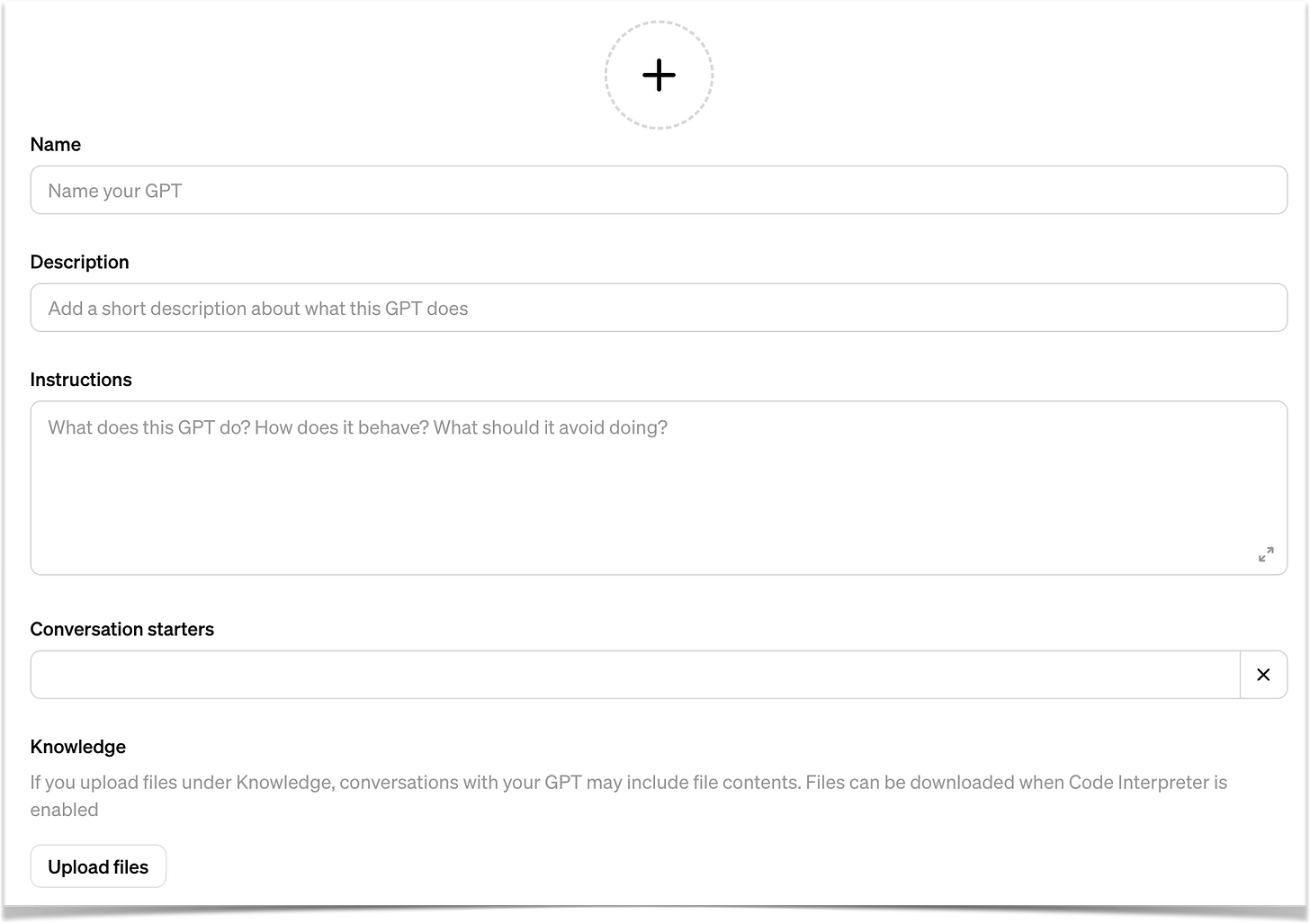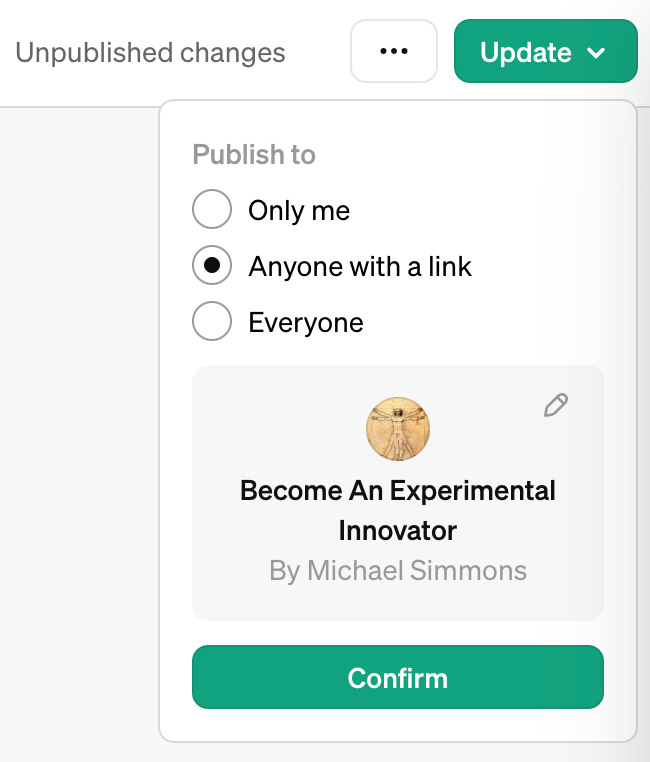Tutorial: Why AI GPTs Are A Big Deal & How To Create Your First One
Author’s Note
Welcome to the third post in the Augmented Reading series. Below are the first two:
Understanding GPTs is key to understanding Augmented Reading. So, if you’re interested in Augmented Reading with AI, I’d highly recommend this article.
Intro
GPTs were announced by OpenAI in November 2023.
To the untrained eye, GPTs may not seem like a big deal. From my perspective, they are absolutely game-changing.
They enable anyone to drastically increase their productivity and boost their learning.
In this article, I will translate what I’m experiencing and the potential I see. More specifically, this article explains:
How GPTs work
Why they’re so important
How to create your first one
Let’s dive in...
How GPTs Work
In layman’s language, GPTs allow you to ‘save’ a prompt you use regularly, share it with others, and even sell it.
Put differently, GPTs allow you to create a software program without the hassle of needing to:
Understand how to code
Pay money for lots of software
String together lots of tools
Hire a team of high-priced experts
For context on what a GPT actually looks like on the back-end, these are the basic fields that you fill in when creating one:
You can think of GPTs as having five core parts:
Packaging
Prompting
Knowledge
Sharing
Actions
GPT Feature #1: Packaging
You can customize the packaging by editing three things:
Icon (+ sign with a circle around it)
Name
Description of GPT
GPT Feature #2: Prompting
Prompting a GPT is just like prompting with ChatGPT. You just put your prompt in the Instructions section.
The big difference is that you can also create four shortcut buttons that users see when they first visit your GPT. Here’s what one of mine looks like:
You create these buttons by adding them in the Conversation Starters section and then triggering them in the instructions. I explain how to do this in the tutorial below.
GPT Feature #3: Knowledge
You can upload up to 20 documents or spreadsheets that the GPT can use as a data source when answering questions. This is where you can upload PDFs of books, articles, and academic studies.
GPT Feature #4: Sharing
Similar to how Google Docs allow you to select different permissions on who you want to share a doc with, GPTs allow for the same:
If you Publish to Everyone, then your GPT will be discoverable via the GPT Store.
GPT Feature #5: Actions
As you get more advanced, you can use Actions, which makes it possible for your GPT to interact with the thousands of programs like:
Gmail
Slack
Google Docs
PluginLabs (to monetize your plugin)
I won’t be talking about actions in this article as they aren’t necessary for getting started. Once you understand the first four features, you can rapidly create an AI bot to help you with Augmented Reading.
Now the questions become…
Who cares about GPTs?
Why are they such a big deal?
The Hidden Power Of GPTs
There are two core benefits that I personally see with GPTs:
Skyrocket your productivity by becoming a one-person knowledge work factory
Accelerate your learning with Augmented Reading
Let me explain each…
Benefit #1: Skyrocket your productivity by becoming a one-person knowledge work factory
In 2022, I spent 500+ hours studying the history of productivity during the Industrial Revolution. This has given me a unique perspective on productivity.
In this section, I distill the relevant part of what I learned…
During the day, we go through a set of sequential steps repeatedly to get our work done. This is known as our workflow.
Workflows can be broken down from projects (days), to tasks (hours), to steps (minutes).
You can see my breakdown of the workflow I use to create blockbuster articles below:
Breaking down your workflow to its smallest components, sequencing those in the right order, and then constantly improving each part is a huge deal.
It is primarily because of these steps that the average productivity of the manual worker in the 20th century increased by 50x, which is astounding when you think about it.
Before the assembly line, craftspeople would spend years apprenticing before they became professionals. After the assembly line, workers with no training could walk in and productively contribute to an assembly line on day one.
Before the assembly line, craftspeople were generalists. After the assembly line, workers would specialize in simple tasks. As a result of this focus, they improved rapidly and had fewer errors. For context, the average length of a task on an assembly line when Ford launched the first assembly line in 1913 was just one minute.
Bottom line, in the 20th century, we shifted from craftspeople producing simple items to unskilled workers at factories producing incredibly complex, standardized items with an extremely low error rate at an incredible scale. This shift brought hundreds of millions of workers out of poverty and drastically reduced the price of everyday items.
Unfortunately, we haven’t been able to use the exact same playbook for knowledge work. Non-routine knowledge work is actually much harder to systematize than routine manual work on several levels. This explains a large part of why our productivity growth rate plateaued as our society shifted to computers and the Internet. Not only that, most knowledge workers still fly by the seat of their pants and haven’t invested the time necessary to break down their workflow and iteratively improve upon it. As a result, when it comes to knowledge work productivity, we are still in the 1800s.
Inspired by The E-Myth Revisited: Why Most Small Businesses Don't Work and What to Do About It, in 2015, I attempted to a blockbuster article factory. More specifically, I attempted to break down my workflow into small parts and hire lots of people for the individual parts. I quickly realized that recruiting, training, and managing dozens (and eventually hundreds) of part-time staff in order to create blockbuster articles wasn’t a tenable model for me and my business model. As I hired more people, I spent less time creating, spent more money, and enjoyed myself less.
The opportunity I see for GPTs is that they enable my original vision to come true:
Rather than having to hire, train, and manage dozens of people, I can create a GPT for each task in my workflow.
Some GPTs will augment a process while others will automate it.
This way I can focus on the parts of the process that I enjoy the most and am most uniquely able to do.
As AI improves, the effectiveness of my GPTs will improve as well.
The following 2-minute video of an AI workflow automation tool gives you a glimpse of what it will be like when you can string GPTs together such that the output of one GPT becomes the input of the next one without your involvement:
Benefit #2: Augment Your Reading With GPTs
I explain the promise of GPTs to help you learn faster and better in the first two articles in the series:
Now that you understand what a GPT is and why it’s game-changing, in the next section I will help you create your first one with a step-by-step tutorial…





